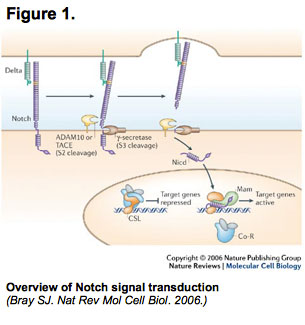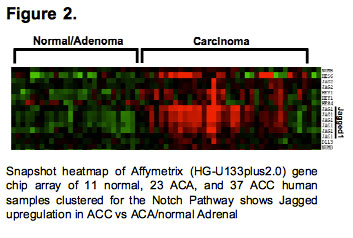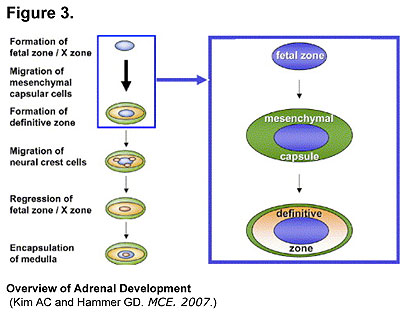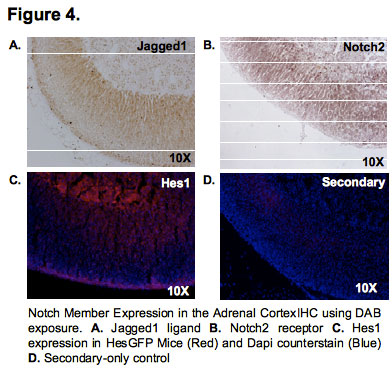Derek P. Simon, B.S.
5th Year Graduate Student (2006-present)
Ph.D. Candidate in Cellular and Molecular Biology

Project Description

Overview of Notch Signaling
Notch signaling is a highly conserved developmental signaling pathway that has also been shown to be important in stem cell biology, organ maintenance, and cancer (for review, see (Bray, SJ 2006)). Canonical Notch signaling is unique in that it requires cell-cell contact and allows direct communication between cells (Figure 1). Five ligands exist (DLL1,3,4 and Jagged1/2) that can interact with any of four Notch receptors (Notch1-4) leading to a series of cleavage events in the receptor-presenting cell that results in release of the intracellular domain from the Notch receptor (NICD). The NICD then associates with the transcriptional repressor CSL and recruits transcriptional coactivators, such as mastermind-like-1 (MAML1), to augment Notch target gene expression. Notch is proving to be a highly important pathway and has been well studied in the development and pathogenesis of numerous tissues and organs (for comprehensive review, see (Bolos, V et al. 2007)).

The Role of Jagged1 and Notch Signaling in Adrenocortical Carinogenesis.
Adrenocortical adenomas (ACA) are fairly common (~4% of the population) and generally present with an optimistic prognosis. In contrast, adrenocortical carcinomas (ACC) are rare, malignant tumors the importance of which is magnified by a dismal prognosis and lack of therapy with proven efficacy (Barlaskar, FM and Hammer, GD 2007). In order for effective treatment to be developed, the pathological molecular changes in ACC must first be identified. Recently our lab performed an expansive microarray study using over 70 adrenal samples including normal, ACA, and ACC. We identified a significant upregulation of the Notch ligand, Jagged1, in ACC when compared to ACA and normal adrenal, which suggests this may be a molecular change occurring in the development of ACC (Figure 2). We confirmed this data by Q-PCR and immunoblot analysis. This is not an isolated observation as a similar expression pattern has been observed in other systems. Jagged1 is also upregulated in hepatocellular carcinoma (Gao, J et al. 2007) in addition to breast cancer where it has been correlated to a poor prognosis (Reedijk, M et al. 2005; Dickson, BC et al. 2007). Furthermore, Jagged1 has been implicated in prostate cancer metastasis (Santagata, S et al. 2004). Unfortunately, no studies have characterized Jagged1-dependent oncogenesis. The goal of this project is to evaluate the role/contribution of Jagged1 and Notch signaling in/to ACC pathogenesis. We are employing a variety of molecular biological tools to interrogate Notch activation and Jagged1 upregulation in a cell culture system.

Notch Signaling in Adrenocortical Development
The adrenal gland is a steroid-producing, endocrine organ located superior to the kidneys that is responsible for the regulation of the mammalian stress response. Adrenal development begins with migration of cells from the coelomic epithelium and the mesonephros and subsequent proliferation to form the adrenogonadal primordium, which eventually separates into the adrenal and gonadal primordia. This fetal adrenal cortex is eventually encapsulated with mesenchymal cells concomitant with migration of medullary cells. The definitive (adult) cortex begins to form and replace the fetal cortex but its origin is still a subject that requires further analysis (For reviews, see (Kim, AC and Hammer, GD 2007), (Kim, AC et al. 2009)). It is unclear if the definitive cortex arises as a result of differentiation of fetal adrenal cells and/or proliferation/differentiation of capsular stem/progenitor cells.
Numerous factors and pathways have been implicated in adrenal development. Steroidgenic factor 1 (SF1) is an orphan nuclear receptor that is required for adrenal steroidogenesis in addition to adrenal development (Luo, X et al. 1994). Our lab has previously demonstrated that the Wnt/Beta-Catenin developmental signaling is essential for adrenal devleopment, possibly through a role in maintenance of stem/progenitor cells (Kim, A et al. 2009). The Notch developmental signaling pathway is very important in vertebrate development and has been implicated in a numerous organs such as heart, lung, bone, skin, and numberous others. Furthermore, Notch ligands, receptors and target genes are expressed throughout the adrenal cortex (Figure 4). We hypothesize Notch signaling is required for development and maintenance of the adrenal cortex.

We are currently addressing this question in vivo using several mouse models.
- Hes1 and Hes5GFP mice will be used to characterize canonical Notch activity throughout development and the adult gland by tracking Hes1 and Hes5 expression which are two of the most well established Notch target genes (Ohtsuka, T et al. 2006).
- Sf1-Cre driver line will be used for tissue specific modulation of Notch signaling in the adrenal cortex (Bingham, NC et al. 2006).
- A Notch overactivation model employing a constitutively active version of the active signaling molecule NICD expressed tissue specifically expressed in the adrenal cortex (Murtaugh, LC et al. 2003).
- A Notch inhibition model, which expresses a dominant-negative version of the essential Notch transcriptional coactivator Maml (DNMaml)(Maillard, I et al. 2004; Tu, L et al. 2005).
- Barlaskar, FM and Hammer, GD (2007). "The molecular genetics of adrenocortical carcinoma." Rev Endocr Metab Disord 8(4): 343-8.
- Bingham, NC, Verma-Kurvari, S, et al. (2006). "Development of a steroidogenic factor 1/Cre transgenic mouse line." Genesis 44(9): 419-24.
- Bolos, V, Grego-Bessa, J, et al. (2007). "Notch signaling in development and cancer." Endocr Rev 28(3): 339-63.
- Bray, SJ (2006). "Notch signalling: a simple pathway becomes complex." Nat Rev Mol Cell Biol 7(9): 678-89.
- Dickson, BC, Mulligan, AM, et al. (2007). "High-level JAG1 mRNA and protein predict poor outcome in breast cancer." Mod Pathol 20(6): 685-93.
- Gao, J, Chen, C, et al. (2007). "Expression of Jagged1 and its association with hepatitis B virus X protein in hepatocellular carcinoma." Biochem Biophys Res Commun 356(2): 341-7.
- Kim, A, Giordano, TJ, et al. (2009). "Wnt/betacatenin signaling in adrenocortical stem/progenitor cells: implications for adrenocortical carcinoma." Ann Endocrinol (Paris) 70(3): 156.
- Kim, AC, Barlaskar, FM, et al. (2009). "In search of adrenocortical stem and progenitor cells." Endocr Rev 30(3): 241-63.
- Kim, AC and Hammer, GD (2007). "Adrenocortical cells with stem/progenitor cell properties: recent advances." Mol Cell Endocrinol 265-266: 10-6.
- Luo, X, Ikeda, Y, et al. (1994). "A cell-specific nuclear receptor is essential for adrenal and gonadal development and sexual differentiation." Cell 77(4): 481-90.
- Maillard, I, Weng, AP, et al. (2004). "Mastermind critically regulates Notch-mediated lymphoid cell fate decisions." Blood 104(6): 1696-702.
- Murtaugh, LC, Stanger, BZ, et al. (2003). "Notch signaling controls multiple steps of pancreatic differentiation." Proc Natl Acad Sci U S A 100(25): 14920-5.
- Ohtsuka, T, Imayoshi, I, et al. (2006). "Visualization of embryonic neural stem cells using Hes promoters in transgenic mice." Mol Cell Neurosci 31(1): 109-22.
- Reedijk, M, Odorcic, S, et al. (2005). "High-level coexpression of JAG1 and NOTCH1 is observed in human breast cancer and is associated with poor overall survival." Cancer Res 65(18): 8530-7.
- Santagata, S, Demichelis, F, et al. (2004). "JAGGED1 expression is associated with prostate cancer metastasis and recurrence." Cancer Res 64(19): 6854-7.
- Tu, L, Fang, TC, et al. (2005). "Notch signaling is an important regulator of type 2 immunity." J Exp Med 202(8): 1037-42.
Curriculum Vitae
Click here to download my CV.
Additional Links
Molecular Biology Resources
Other Links
References






